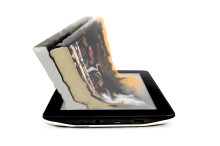In today’s multichannel world, catalogs thrive as an integral tool in marketing plans. A 2016 study by Infotrends, a market and strategic consulting firm, found that 62% of customers who received catalogs were influenced by the catalog to make a purchase.
Catalogs continue to engage a variety of customers, regardless of their age. Millennials who are known for their digital connection are just as likely to purchase from a catalog compared to their elder counterparts.
What does this tell us? Printed, mailed catalogs remain a constant visual reminder, an essential tool and a motivator to buyers. Printed catalogs have a unique way to connect customers across a wide variety of channels and expand options for customers. Print connects customers to digital channels and vice versa. Customers who receive catalogs are known to increase online sales.
Catalogs can stay connected to mobile users by offering digital friendly options such as:
Scan by phone
View by desktop, laptop, and tablet
Link to social media
Link to website
Email/Newsletters
This combination of marketing connects customers across multiple channels and opens a wide range of opportunities. Millennials who “check in” on Facebook can receive tips and product information which can be sent to their phones. Their phones can link to “send me a catalog” for more detailed information on each product.
Email is an inexpensive tool which can be utilized in conjunction with catalogs by alerting customers to discounts, sales or must have items in the upcoming catalog. Websites and digital marketing can facilitate a seamless transition to catalogs by mirroring the content, overall tone, and language of the catalog.
Customers like what they are most familiar with, and website browsing can be overwhelming and frustrating for customers as they have to explore the page and often seek out items. Items can easily be bookmarked, circled, or saved on paper, unlike on the internet. Catalogs are easy to navigate and the information is accessible at any given time. This is more convenient and user friendly compared to its counterpart: the internet. Websites can require a username and login to save items. How many times have you wanted to search and/or save an item for later without having to create an account that you may not need again?
Catalogs are tangible, and unlike a website, email, or app on a phone, catalogs find a place in homes of customers and serve as a reminder to take action, not just to the homeowner, but to neighbors, family and friends who stop by.
An InfoPrint survey revealed customers still prefer print over email. Print is accessible, always. Website information, on the other hand, is only as attainable as a customer’s ability to maneuver the search engine. How many times have you gone to a site and the link displays an error code?
Today, customers take information from a variety of sources and digital channels. While all channels serve a purpose, integrating digital avenues with catalogs promotes customer interest and drive sales through a wide range of channels. Catalogs remain as a highly effective tool in multichannel marketing to reach a diverse group of current and prospective customers.